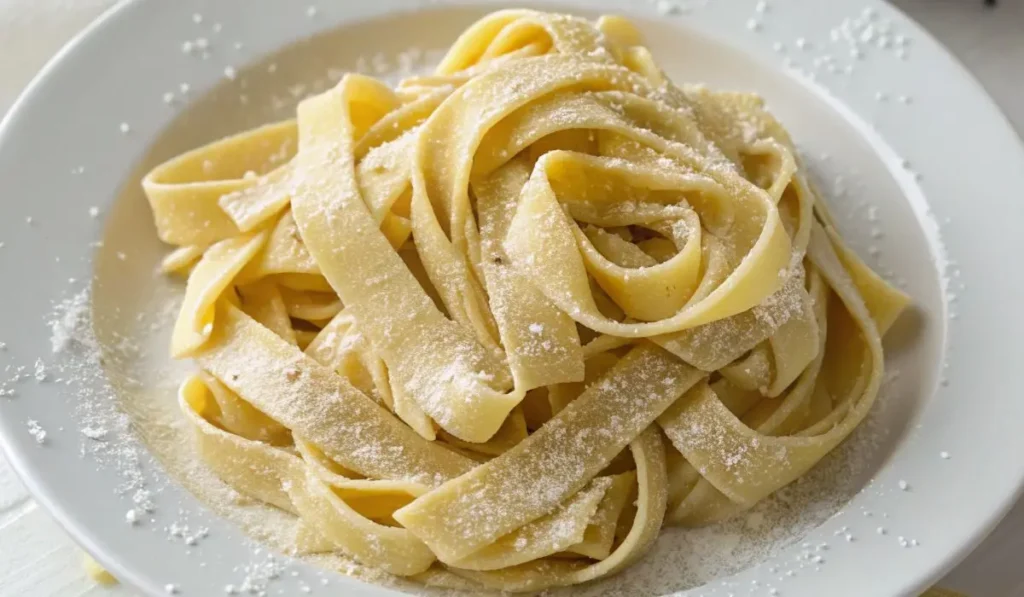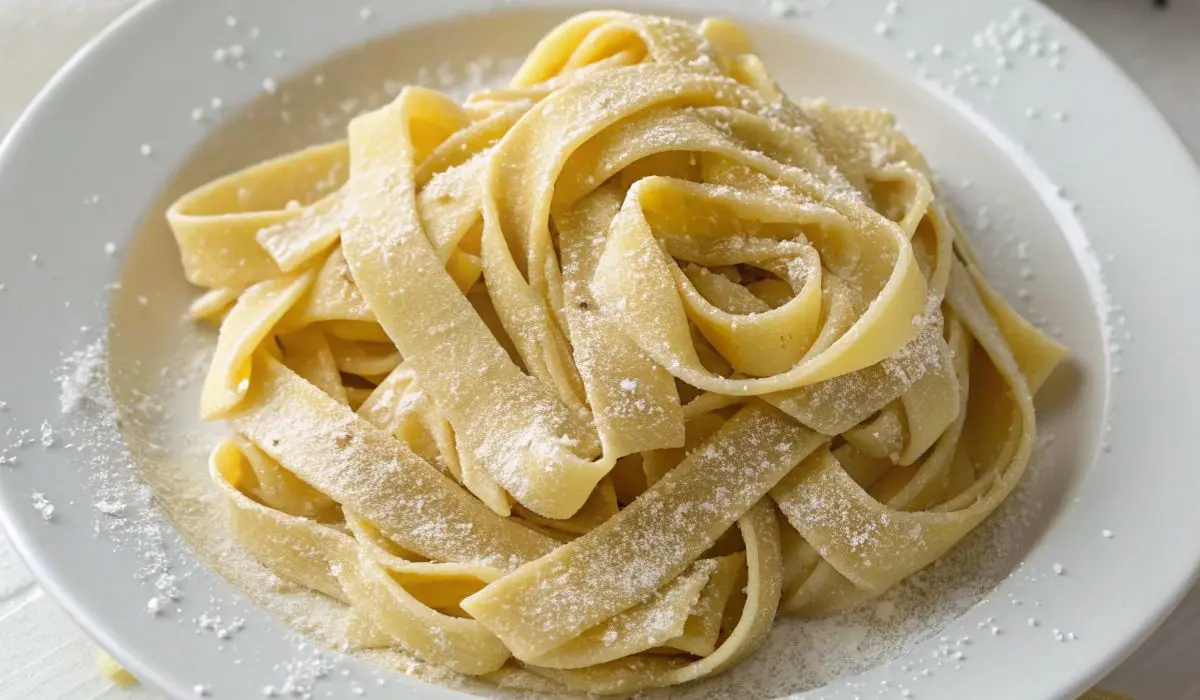Making fresh pasta at home sounds fancy, but it’s actually surprisingly simple. You only need four basic ingredients and about an hour of your time. The result? Chewy, delicious noodles that taste miles better than anything from a box.
I discovered this truth during a rainy weekend when I decided to try making pasta from scratch. What started as a fun experiment became a weekly tradition. Now, I can’t imagine going back to store-bought pasta when homemade tastes this good.

Why Make Your Own Pasta?
Fresh pasta has a completely different texture than dried pasta. It’s bouncy, tender, and has a rich flavor that pairs beautifully with simple sauces. Plus, you control every ingredient that goes into it.
The best part? You probably have everything you need in your kitchen right now.
What You Need for This Pasta Recipe
This pasta recipe uses just four ingredients:
- All-purpose flour. Regular flour works perfectly. You don’t need fancy 00 flour or semolina
- Eggs. These add richness and help bind the dough together
- Olive oil. A small amount keeps the dough moist and workable
- Salt. For flavor in both the dough and cooking water
That’s it. No special equipment required, though a pasta maker does make rolling easier.
Step-by-Step Instructions
Follow these simple steps to make perfect pasta at home:
- Make the dough well. Place 2 cups of flour on a clean counter and create a well in the center. Crack 3 eggs into the well and add half a teaspoon of salt and half a tablespoon of olive oil.
- Mix the ingredients. Use a fork to gently beat the eggs while keeping the flour walls intact. Slowly incorporate flour from the edges using your hands. The mixture will look shaggy at first.
- Knead the dough. Knead for 8 to 10 minutes. At first, it feels dry and crumbly, but after about 8 minutes, it transforms into something smooth and elastic. Add tiny amounts of water if too dry, or dust with flour if too sticky.
- Rest the dough. Wrap the finished dough in plastic wrap and let it rest for 30 minutes at room temperature. This allows the flour to fully hydrate.
- Divide and flatten. Cut the rested dough into four pieces. Work with one piece at a time, keeping the others covered.
- Roll the pasta. If you have a pasta maker, flatten each piece slightly and run it through the widest setting three times. Fold the dough in half lengthwise, then continue rolling through progressively narrower settings. Without a pasta maker, use a rolling pin to roll as thin as possible.
- Cut your pasta. Cut pasta sheets into your preferred shape. Fettuccine and tagliatelle work great for beginners. Dust with flour to prevent sticking.
Cooking Fresh Pasta
Fresh pasta cooks much faster than dried pasta. Bring a large pot of salted water to a rolling boil. Add your pasta and cook for just 1 to 2 minutes. Fresh pasta is done when it floats to the surface and has a slight bite to it.
Serving Suggestions
Fresh pasta shines with simple preparations. Try these combinations:
- Olive oil, garlic, and Parmesan cheese
- Classic marinara sauce
- Homemade pesto
- Butter and fresh herbs
- Alfredo sauce for special occasions
The rich flavor of homemade pasta means you don’t need complicated sauces. Often, the simplest preparations taste the best.
Storage Tips
Fresh pasta can be stored in the refrigerator for up to two days. Wrap it well in plastic wrap to prevent drying out. You can also freeze uncooked pasta for up to three months. Just dust it heavily with flour before freezing.
Common Mistakes to Avoid
- Don’t add too much flour while kneading. The dough should feel slightly tacky but not sticky. Too much flour makes tough pasta.
- Don’t skip the resting time. This step is crucial for workable dough.
- Don’t overcook fresh pasta. It cooks much faster than dried pasta and can become mushy quickly.
Final Thoughts
Making pasta from scratch connects you to centuries of cooking tradition. It’s meditative, rewarding, and surprisingly practical. Once you taste homemade pasta, you’ll understand why it’s worth the effort.
Start with this basic pasta recipe and experiment from there. Add herbs to the dough, try different shapes, or create your own sauce combinations. The possibilities are endless when you know how to make great pasta at home.

Homemade Pasta
Ingredients
Equipment
Method
- Place 2 cups of flour on a clean counter and create a well in the center. Crack 3 eggs into the well and add half a teaspoon of salt and half a tablespoon of olive oil.
- Use a fork to gently beat the eggs while keeping the flour walls intact. Slowly incorporate flour from the edges using your hands. The mixture will look shaggy at first.
- Knead for 8 to 10 minutes. At first, it feels dry and crumbly, but after about 8 minutes, it transforms into something smooth and elastic. Add tiny amounts of water if too dry, or dust with flour if too sticky.
- Wrap the finished dough in plastic wrap and let it rest for 30 minutes at room temperature. This allows the flour to fully hydrate.
- Cut the rested dough into four pieces. Work with one piece at a time, keeping the others covered.
- If you have a pasta maker, flatten each piece slightly and run it through the widest setting three times. Fold the dough in half lengthwise, then continue rolling through progressively narrower settings. Without a pasta maker, use a rolling pin to roll as thin as possible.
- Cut pasta sheets into your preferred shape. Fettuccine and tagliatelle work great for beginners. Dust with flour to prevent sticking.
- Bring a large pot of salted water to a rolling boil. Add your pasta and cook for just 1 to 2 minutes. Fresh pasta is done when it floats to the surface and has a slight bite to it.
